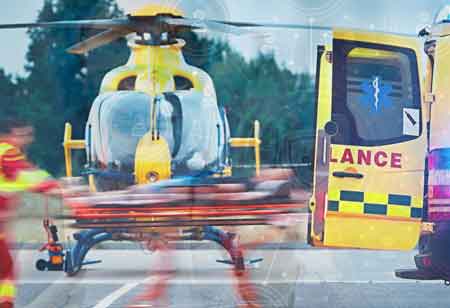Thank you for Subscribing to Healthcare Business Review Weekly Brief

Role of Air Ambulances in Emergency Medical Transport
Healthcare Business Review
The aircraft quickly transports medical personnel, supplies, and equipment to affected areas, facilitating evacuation critically injured individuals.
Air ambulances provide rapid and specialized medical transport for individuals facing critical medical conditions or emergencies. These specially equipped aircraft are designed to transport patients quickly and safely, often covering large distances or reaching remote areas where traditional ground ambulances face challenges. The primary use of air ambulances is in emergency medical evacuations. When individuals face life-threatening situations such as trauma, severe injuries, or critical medical conditions, air ambulances offer a rapid means of transportation to specialized medical facilities. It is crucial when time is of the essence, and access to immediate medical care can make a significant difference in patient outcomes.
Air ambulances are often deployed in response to traumatic incidents or accidents where patients require urgent medical attention. Air ambulances can swiftly transport patients to trauma centers or hospitals equipped to handle critical injuries in severe car accidents, natural disasters, or industrial incidents. The rapid response is essential for improving survival rates and reducing the long-term impact of traumatic injuries. Air ambulances are equipped to handle specialized medical needs, including the transfer of neonatal and pediatric patients. Newborns and young children with critical medical conditions may require transportation to specialized pediatric hospitals or neonatal intensive care units.
Air ambulances have the medical equipment and trained personnel to ensure these vulnerable patients' safe and timely transfer. Time is a critical factor in organ transplants, and air ambulances play a crucial role in transporting organs from donors to recipients. These flights are meticulously planned to ensure the organ's viability during transportation. Air ambulances offer a swift and efficient means of overcoming geographical distances, enabling timely organ transplants and potentially saving lives. Air ambulances become essential in remote or inaccessible areas where traditional ground ambulances may struggle to reach. It includes rural regions, mountainous terrain, islands, or locations with challenging infrastructure.
Air ambulances can swiftly transport patients from these locations to hospitals to receive the necessary medical care. A patient who has a critical medical condition, such as a severe heart attack, respiratory problem, or neurological emergency, may require specialized care available only at certain medical facilities
Air ambulances are equipped with advanced life support systems, allowing for the safe transport of patients requiring intensive care. It ensures that patients receive continuous medical monitoring and intervention during the transfer. When individuals fall ill or are injured while abroad and require specialized medical care available in their home country, air ambulances facilitate the safe transfer across borders.
Air ambulances are frequently used for international medical repatriation. It involves coordinating with medical teams in departure and destination countries to ensure a seamless patient transfer. Air ambulances are integral to search and rescue operations, especially in challenging terrains or during natural disasters. They can quickly locate and evacuate distressed individuals, providing immediate medical attention and transport to a suitable medical facility. The capability is crucial in disaster-stricken areas or locations with limited accessibility. Air ambulances are vital during disaster relief efforts following earthquakes, floods, or hurricanes.
The medical professionals on board air ambulances, including doctors, nurses, and paramedics, are highly trained and experienced in critical care situations. These specialized medical teams can administer advanced medical interventions during transit, ensuring continuous care for patients with complex medical needs. The aircraft has state-of-the-art medical equipment, monitoring devices, and life support systems, creating a controlled medical environment for timely and effective interventions. This capability makes air ambulances indispensable in transferring patients who require advanced medical care beyond the capabilities of traditional ambulances. The rapid and coordinated response is essential in minimizing the impact of disasters on public health.
Air ambulances serve a wide range of critical functions in emergency medical transportation. From responding to immediate life-threatening situations to facilitating the transfer of patients with specialized medical needs, these aircraft play a vital role in improving patient outcomes and saving lives. Their ability to quickly cover large distances, access remote areas, and provide a controlled medical environment during transport makes air ambulances indispensable to modern healthcare systems. Air ambulances are vital to the broader emergency medical infrastructure, offering a versatile and rapid response to various critical situations.









